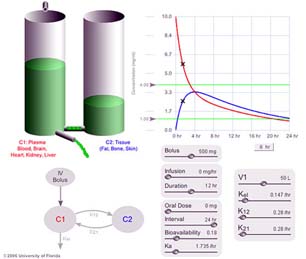|
In this hydraulic analog visualization of drug concentration in the body, drug in body tissues behaves in the same way as water in a cylindrical vessel. Each vessel represents a compartment. For a given compartment, the height of the meniscus and the volume of water are equivalent to the concentration and amount of the drug respectively. The cross-sectional area of the vessel represents the volume of distribution.
If there is a small hole at the bottom of a vessel, water will drain out such that the rate of emptying is proportional to the meniscus height. If the vessel is full (high meniscus height), liquid will stream out of the hole; if the vessel is almost empty (low meniscus height), liquid will slowly drip out of the hole. Similarly, the liver and kidneys actively remove drugs dissolved in the blood according to the concentration of the drug. The same mathematics can be used to describe both systems. Often, a single cylindrical vessel is not quite enough to describe a drug because other body tissues like fat tend to soak up and release the drug from the blood. If a second vessel is connected to the first through a tiny tube, then some liquid from the first will flow into the second through the tube. When enough liquid has been drained out of the first vessel, the second vessel will discharge into it, slowing down the rate at which the first vessel empties. Drug in the body works the same way; it is absorbed in blood and fatty tissues, and it is removed from the blood through the liver and kidneys. |

Click to run simulation |

